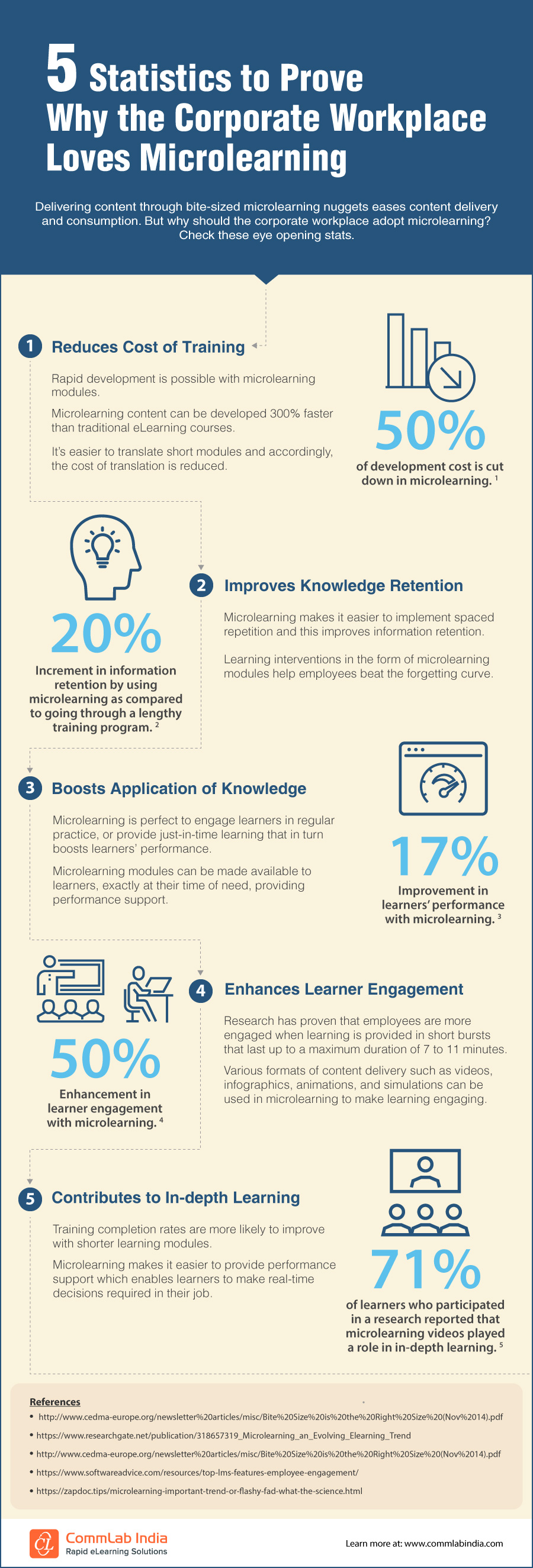5 Statistics to Prove Why the Corporate Workplace Loves Microlearning [Infographic]
![5 Statistics to Prove Why the Corporate Workplace Loves Microlearning [Infographic] 5 Statistics to Prove Why the Corporate Workplace Loves Microlearning [Infographic]](https://blog.commlabindia.com/hubfs/Imported_Blog_Media/microlearning-for-effective-training-1-1.jpg)
Microlearning is not a new concept. This approach of learning in short, repetitive bursts that cover content that increases in complexity has been around for centuries. Microlearning has begun to attract more attention in recent years, with its increasing popularity in the corporate sector. Microlearning in corporate training is not a fad, it’s a trend that most probably will stay evergreen in the learning and development (L&D) space.
→ Download Worksheet Now: Understanding What Microlearning is and What it isn’t
The best way to make learning interesting for your employees is to provide training content that’s short and interesting. Be it knowledge retention or its practical application, learning in smaller chunks ensures sticky learning. Because microlearning is focused on covering one performance objective at a time, it makes learning relevant to learners. Also, it’s easier to access short modules of learning through mobile devices. Why should you consider adopting microlearning at your workplace? Check this infographic that lists 5 statistics that can prove to be an eye-opener.
5 Popular and Effective Microlearning Formats for Modern Corporate Workplaces
1. Interactive Videos
Interactive videos are short video clips enriched with elements that encourage user engagement. These elements can include clickable hotspots, quizzes, or branching scenarios. For employee onboarding, an interactive video might introduce the company culture, mission, and values with embedded quizzes to ensure understanding. In product training, it can showcase features with clickable hotspots for more in-depth information.
2. Infographics
Infographics are visual representations of information using graphics, charts, and minimal text. They condense complex information into easily digestible visuals, making them ideal for quick reference guides. For example, an infographic can summarize a new company policy, displaying key points, timelines, and contact information in a visually appealing format. Infographics are particularly effective when conveying statistical data or process flows.
3. Podcasts/Audio Nuggets
Podcasts or audio nuggets are short, focused audio recordings covering specific topics. They are convenient for on-the-go learning, such as during commutes or while exercising. For sales teams, these might include brief updates on new products or sales techniques. Leadership development podcasts could cover topics like effective communication or time management. Including interviews with industry experts can add diversity and depth to the content.
4. Scenario-Based Learning
Scenario-based learning presents learners with real-life situations, allowing them to make decisions and witness the consequences. For decision-making skills, scenarios might involve choosing between different business strategies. In conflict resolution training, scenarios can simulate workplace conflicts, and learners must choose the best resolution. This format enhances critical thinking and problem-solving skills in a practical context.
5. Mobile Learning Apps
Mobile learning apps deliver bite-sized lessons through smartphones or tablets, providing flexibility for employees to learn at their own pace. These apps can cover a range of topics, from soft skills to compliance training. Interactive features within the app, such as quizzes or discussion forums, promote engagement. Mobile apps also often include features like push notifications to remind learners of upcoming lessons or assessments.
Wrapping Up!
Microlearning is a popular approach in corporate training, providing short, focused bursts of information to learners. Remember that the effectiveness of microlearning formats can vary based on the learning objectives, audience, and content. Combining multiple formats in a blended learning approach can offer a well-rounded training experience. To understand more about what microlearning is and what it isn’t, you can check out this worksheet now!
Editor’s note: This post was originally published in December 2018 and has been updated for comprehensiveness.






![Understanding Microlearning – What it is and What it Isn’t [Video]](https://blog.commlabindia.com/hubfs/Imported_Blog_Media/microlearning-what-it-is-webinar-video.jpg)
![Microlearning Trends to Look Out For in 2024 [Infographic]](https://blog.commlabindia.com/hubfs/blogs/microlearning-trends-look-out-for-info.jpg)